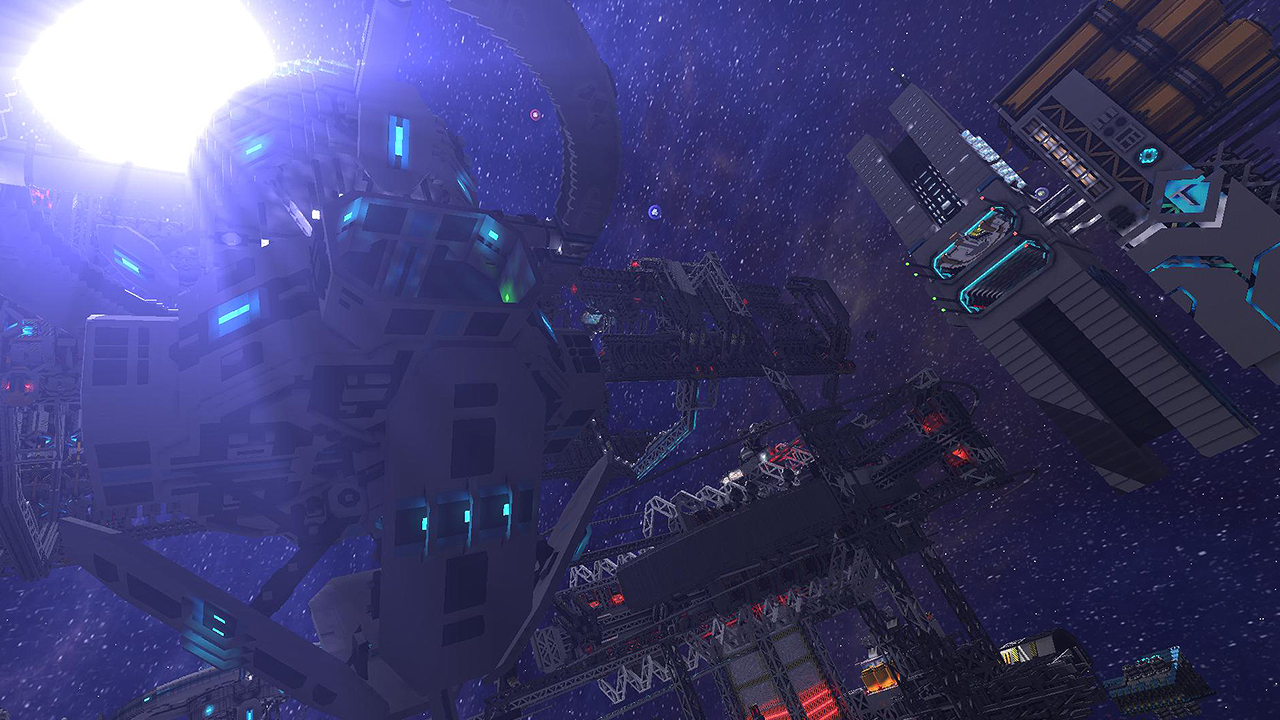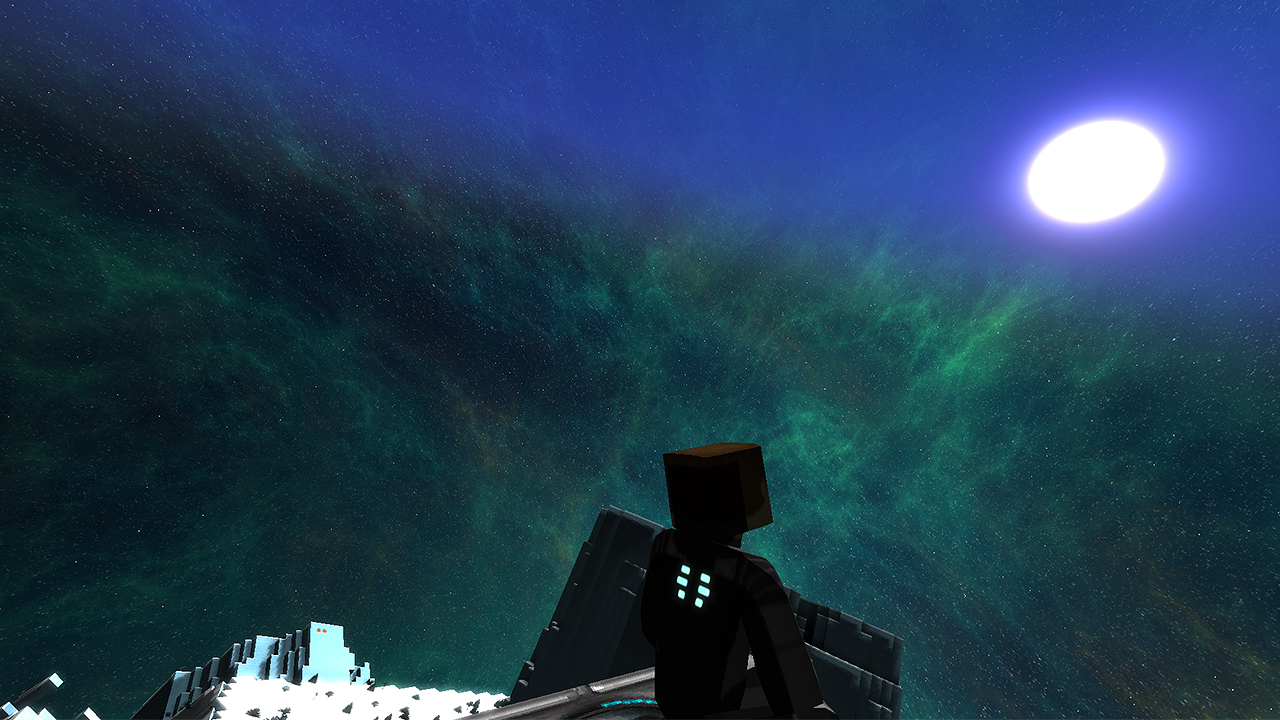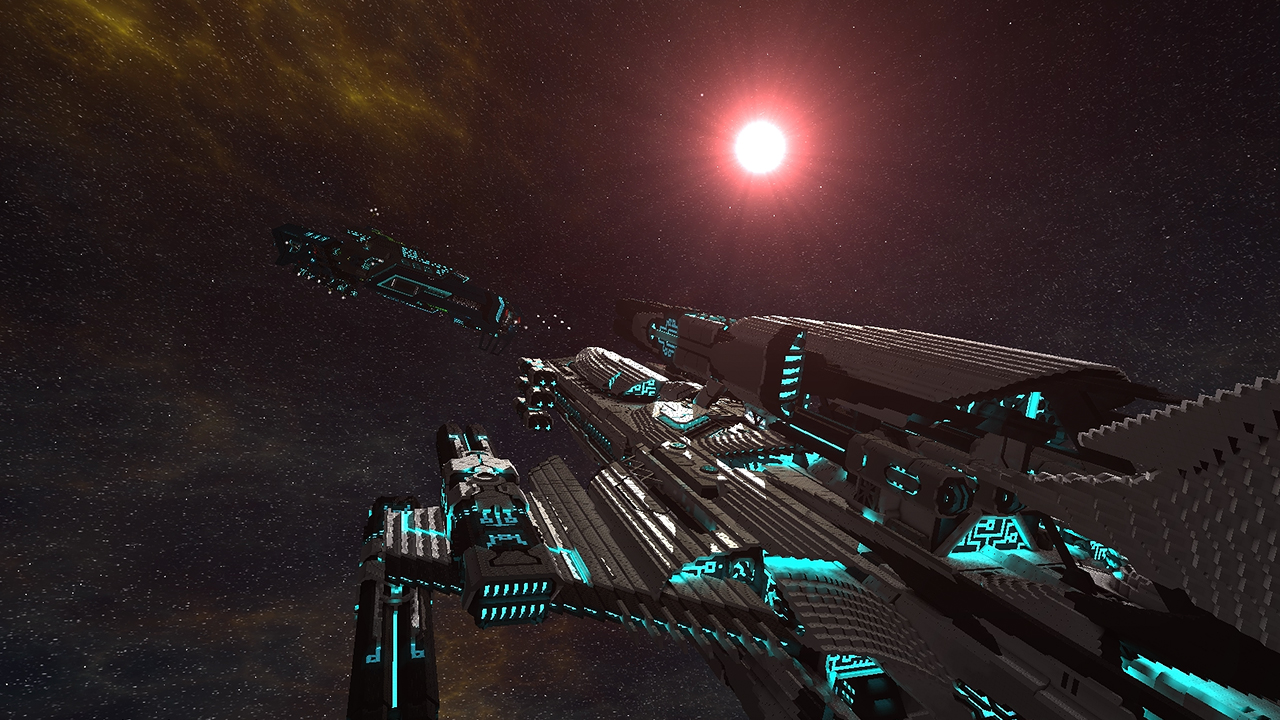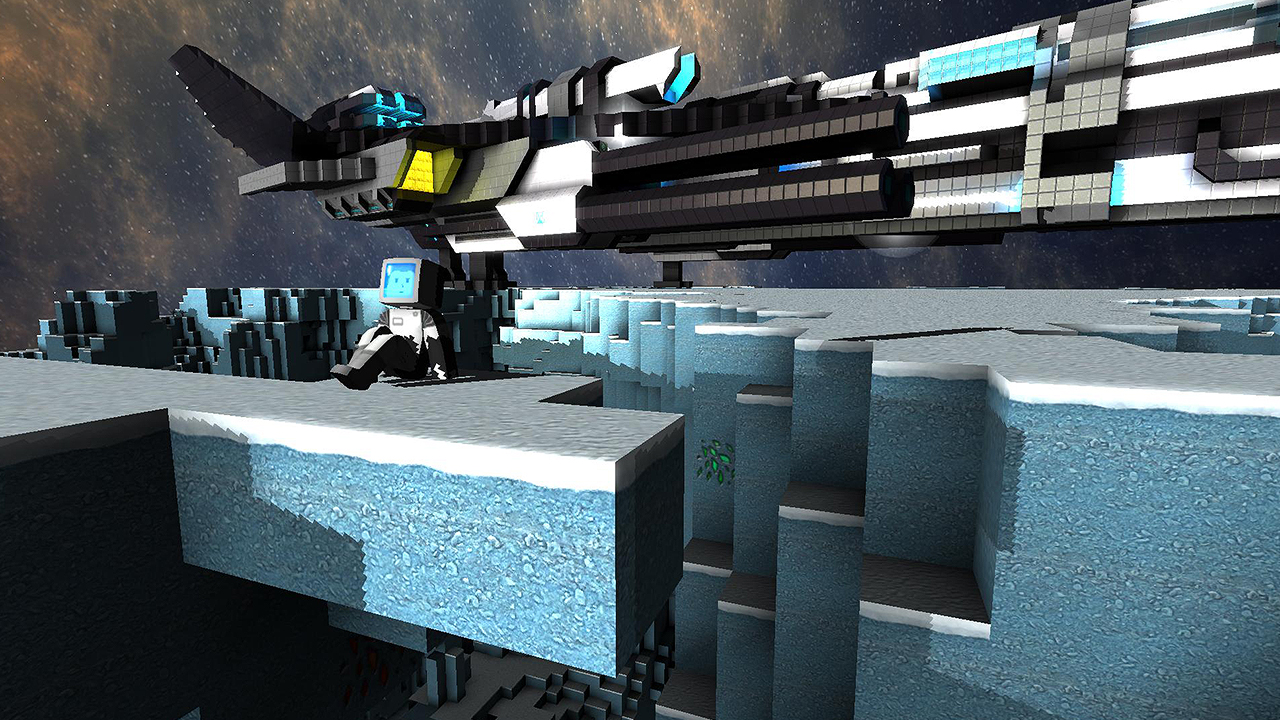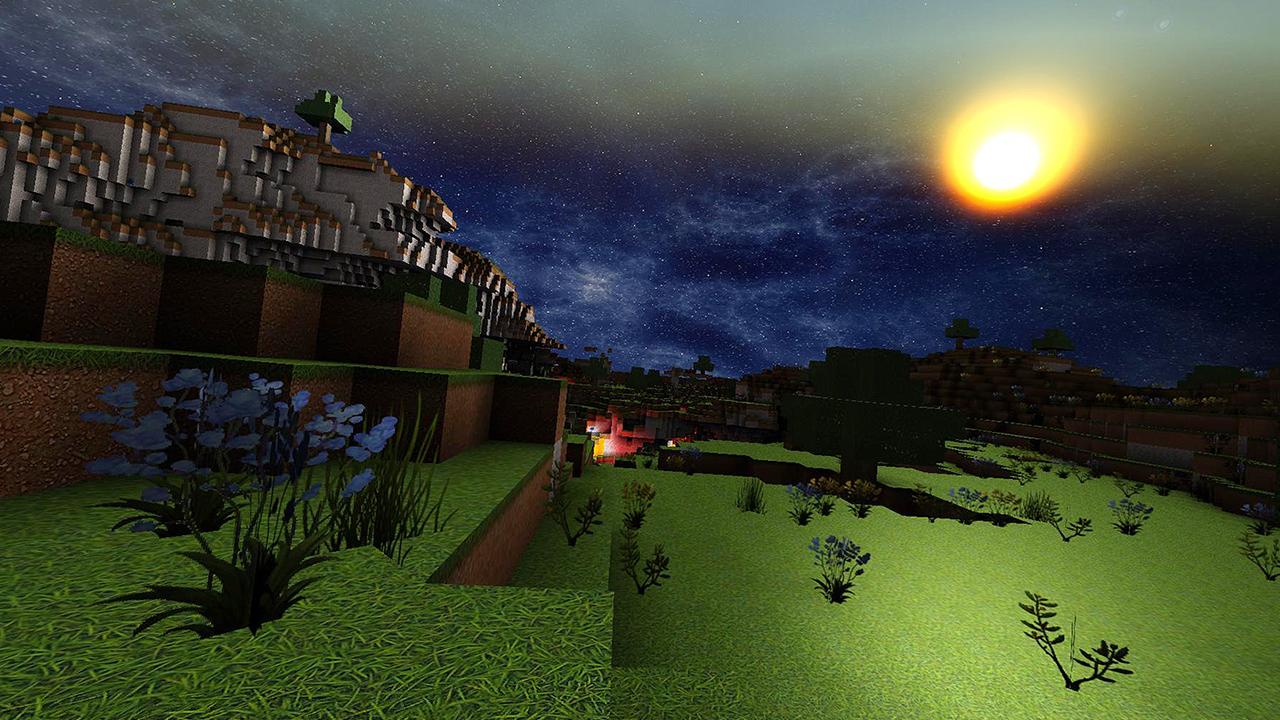A voxel-based 3D sandbox set in the never-ending darkness of space. Create your own ships, explore new galaxies, stars and planets. Discover and salvage space stations, fight against pirates or opposing factions in multiplayer. Equip your ships with completely customisable weapons and conquer the galaxy. Trade and make a fortune, mass produce materials in gigantic factories. Design your very own space station. Create warp gates and network the universe at your front door.
The universe is a vast, mystical, beautiful, awe-inspiring place.... the universe is yours.
Built for scalability to facilitate massive fully interactable objects, almost anything is possible. Gameplay elements have been skillfully constructed to bring the ultimate space sandbox experience.
Dive into your own unique universe, and choose your path.
The universe is a vast, mystical, beautiful, awe-inspiring place.... the universe is yours.
Built for scalability to facilitate massive fully interactable objects, almost anything is possible. Gameplay elements have been skillfully constructed to bring the ultimate space sandbox experience.
Dive into your own unique universe, and choose your path.
Key Features:
- Procedurally generated infinite universe, with quadrillions of galaxies - The universe is massive. It'd take approximately 10,000 years to cross from one end to the other! Singleplayer and Multiplayer worlds can be heavily customised with our extensive config options.
- Developed for scalability- We have a broad range of graphical and performance options that cater to our low-end users as well as those with heavy rigs and servers.
- Advanced Build Tools - Powerful and easy to use building tools, quickly design awesome ships, stations and bases. Including functions: Copy & paste, undo, redo, replace, symmetry modes, shape assistance systems (spheres, cycles, torus and more) and rotation of templates.
- Modular Weapon Systems - Combine weapon systems for countless configurations of weapons. From sniper beams to swarm missiles.
- Comprehensive Rail & Logic Systems - Use the rail system to build moving parts. You can do anything from simple elevators, sliding or rotating doors, to complex cranes.
Tinker with our logic systems to control any system in the game, be it weapons, lights, rails, or explosives. Logic covers all basic gate types for convenient use (AND, OR, NOT, DELAY, Flip-Flop), allows in flight control and wireless connections between entities. You can use it for simple things like timers, switches, buttons. Or, build complex systems like working clocks and even a real CPU. - Community multiplayer (dedicated servers) - Play with others in our community hosted servers. Our configs allow administrators to customise core game mechanics for a tailored experience. Most settings can be tweaked to squeeze the best performance out of hardware.
- Platform independent (Windows, Linux, Mac) - StarMade is completely platform independent. We support the three most widely used operating systems.
- Free to play in alpha - We offer the full game free to play while in alpha development. Play our game through this period for free while in return we receive invaluable feedback and bug reports.
Devblog 11th July 2017 - End Goal Document Part 1
Not to mention that as a player, you can only see what’s in the game right now and how that all ties together. You do not see what we want to achieve at the very end, making it impossible to give accurate feedback when the big picture is simply not there for you to see.
When we talked about how to write this document, we simply put ourselves into a specific play role/play style, defining what we would like to be able to do in the finished game. Coming up with ideas was easy, but getting rid of just as many to form a solid, cohesive game was not. StarMade is after all, a sandbox game. A type of genre where you’re allowed to discover a complete world and do whatever you want.
It’s unlikely that we’re going to change our end goals significantly, but the features leading up to it are subject to change. A destination often has multiple roads leading to it, which one we pick depends on our personal opinion and the community’s feedback on it.
As for the document itself, we’ve divided it up into several player roles which coincidentally gives us some time to make a nicer public version of it as we can release it in parts. Of course at the end, we’ll bundle it up in a single thread so that you don’t have to piece it all together yourself.
All of this is based on a base goal, which is purposely kept very simple:
StarMade is a space sandbox game where you start with very little and work your way up to the top.
You are put in a galaxy for you to explore. How you want to go about it and what your final role is going to be, is left to the player. The driving force behind it all is progression, without restricting creativity and freedom.
The roles we will talk about are the following:
~ Builder
~ Explorer
~ Industrialist
~ Trader
~ Fighter
~ Imperialist
Some of the roles of course overlap and/or have sub-roles, which will be reflected in the other parts of this document.
Starting from close to nothing, you’ll have to do some form of building first to at least travel where you want to go. While you’re doing that, you get to know what StarMade’s backbone has to offer. Mining, simple early game trading, basic ship building and travelling around the universe would all come to light in the first few hours. As soon as you have a functional ship, you can focus on anything that you’ve liked so far.
If you, up till now, prefer building above anything else, you will most likely continue in that direction. Your ultimate goal is a never ending one, to make better and more creations. This on its own, is already a form of progression which is limited by your own player experience. However, this might not be enough for most players and we need a more controlled form of progression on the game’s side to help with that.
We want to slowly open up this building aspect to the player, not only to make sure there’s still things left to explore later on...but also to make sure the player isn’t overwhelmed at the very start. Later, when you’re base of operations is well established, you slightly shift your focus from building to selling and marketing. Your goal isn’t necessarily to get rich, but to get known as a reliable ship builder that is capable of doing anything. Not only are you better at building now, but your ship/station producing speed is much faster after upgrading and maintaining your own shipyard(s) along the way.
Several features, as well as redesigning or tweaking existing systems will make this vision a reality.
By fine tuning the crafting recipes and universe resource allocation system, we can create an unique world where, as a builder, you’ll have to play differently every time you generate a new universe. If certain block resources are tied to specific locations, you won’t be able to immediately build any block in large quantities. Those resources could still be found anywhere, but just in small quantities to allow small scale experimentation and open your mind to new possible ways.
The idea here is that the player will have to adapt to the resources they have at their base and fully explore the functional blocks they can create there before moving on.
Rails, logic and other similar systems, are just like decoration when it comes to performance. These already provide a large amount of end-game content which can only be fully utilized by players that are experienced with it. There is no need to add additional progression here.
Some functional blocks do need some extra depth to lengthen the amount of time needed to achieve this endgame build quality. The key could be in the balance between efficiency versus longevity. Longevity is where your ship can survive a decent amount of incoming damage and is still able to fight back afterwards. Efficiency is where you get the most statistical value out of your ship compared to its build cost and mass. Balancing these 2 out is a never ending task and depends on the ship’s purpose and its potential opponents. Right now we already have this in multiple ways, but it could be way more prominent by changing how some systems work.
Rebalancing systems will also provide more defined roles for differently sized ships. Small ships, while they never should be as powerful as a considerably larger ship in a 1 vs 1 fight, would still be extremely useful when used in larger numbers. In addition to that, some weapon systems could benefit greatly depending on the ship type and role.
Shipyards also make it possible to build and maintain more than one ship. That combines nicely with the fleet mechanic to open up a lot more gameplay possibilities for the builder Suddenly all of your previously build ships get a different purpose if you put them together in a fleet. This would change your perspective and your way of building ships, adding even more progression for the player to explore.
Shipyards would also be the gateway to open up trading for more than just a bunch of blocks, as instead, you will trade real ships or their designs for other people to make more. Before we can get to that stage though, the blueprint system would need to support this form of trading and security.
Of course, there is still a lot of work to be done on shipyards to have them fully fulfil their role.
We could add more build tools, decorative blocks and smaller UI elements. All of that needs to be based on something the player already knows. If something entirely new is introduced, it should be applied on existing systems too where applicable to keep everything consistent with each other, streamlining the player experience even more.
Preparing the UI for further expansion is a necessity even in an alpha stage, but non essential additions would be more useful for the beta stage or post release.
That was it for the builder part, we hope this gives you some more insight to our gameplay decisions and the road we’re taking. Stay tuned for the next part, where we will go more into roles that aren't as prominent yet in the current game version.
If you’re interested of helping us out with testing, make sure to check out our pre-release post here . Remember to always use a separate installation for preview builds as they may potentially include game-breaking issues.
If you come across anything new that doesn’t work or you believe you’ve located a new bug, report that here to help us out: Report a Bug (Release Candidate)
As always, thank you for playing StarMade!
~ The Schine Team
Greetings, citizens ~
A few months ago, we planned to release our End-Goals document but never really got around to make a public version. As announced in the previous post, this dev blog contains
End Goals Introduction
Our “End Goals” document...is not a list of features. Although a simple feature list is useful to get an overview of what’s next, it is not a great way to show the public what our game is about and where we’re going with it. New feature ideas get added, changed or removed all the time which only makes it more important to not depend on them when we’re talking about the final product.Not to mention that as a player, you can only see what’s in the game right now and how that all ties together. You do not see what we want to achieve at the very end, making it impossible to give accurate feedback when the big picture is simply not there for you to see.
When we talked about how to write this document, we simply put ourselves into a specific play role/play style, defining what we would like to be able to do in the finished game. Coming up with ideas was easy, but getting rid of just as many to form a solid, cohesive game was not. StarMade is after all, a sandbox game. A type of genre where you’re allowed to discover a complete world and do whatever you want.
It’s unlikely that we’re going to change our end goals significantly, but the features leading up to it are subject to change. A destination often has multiple roads leading to it, which one we pick depends on our personal opinion and the community’s feedback on it.
As for the document itself, we’ve divided it up into several player roles which coincidentally gives us some time to make a nicer public version of it as we can release it in parts. Of course at the end, we’ll bundle it up in a single thread so that you don’t have to piece it all together yourself.
All of this is based on a base goal, which is purposely kept very simple:
StarMade is a space sandbox game where you start with very little and work your way up to the top.
You are put in a galaxy for you to explore. How you want to go about it and what your final role is going to be, is left to the player. The driving force behind it all is progression, without restricting creativity and freedom.
The roles we will talk about are the following:
~ Builder
~ Explorer
~ Industrialist
~ Trader
~ Fighter
~ Imperialist
Some of the roles of course overlap and/or have sub-roles, which will be reflected in the other parts of this document.
Builder
Our first player role to be addressed is also the one with the most work put into it: the Builder. From all roles, this one is probably also the most realized in the game already.Starting from close to nothing, you’ll have to do some form of building first to at least travel where you want to go. While you’re doing that, you get to know what StarMade’s backbone has to offer. Mining, simple early game trading, basic ship building and travelling around the universe would all come to light in the first few hours. As soon as you have a functional ship, you can focus on anything that you’ve liked so far.
If you, up till now, prefer building above anything else, you will most likely continue in that direction. Your ultimate goal is a never ending one, to make better and more creations. This on its own, is already a form of progression which is limited by your own player experience. However, this might not be enough for most players and we need a more controlled form of progression on the game’s side to help with that.
We want to slowly open up this building aspect to the player, not only to make sure there’s still things left to explore later on...but also to make sure the player isn’t overwhelmed at the very start. Later, when you’re base of operations is well established, you slightly shift your focus from building to selling and marketing. Your goal isn’t necessarily to get rich, but to get known as a reliable ship builder that is capable of doing anything. Not only are you better at building now, but your ship/station producing speed is much faster after upgrading and maintaining your own shipyard(s) along the way.
Several features, as well as redesigning or tweaking existing systems will make this vision a reality.
Block Availability
At the moment, all blocks can be easily bought or made in large quantities with only a few small steps. Every resource you need can be gathered in almost any star system which is concern when you try to get more progression into the game. Base blocks such as power, basic hull and thrusters still need to be easily crafted no matter where you are, yet more advanced systems that you don’t need from the start, such as effects and the future reactor chamber blocks, could definitely use some changes.By fine tuning the crafting recipes and universe resource allocation system, we can create an unique world where, as a builder, you’ll have to play differently every time you generate a new universe. If certain block resources are tied to specific locations, you won’t be able to immediately build any block in large quantities. Those resources could still be found anywhere, but just in small quantities to allow small scale experimentation and open your mind to new possible ways.
The idea here is that the player will have to adapt to the resources they have at their base and fully explore the functional blocks they can create there before moving on.
Block Progression
Most decorative blocks should always be available and cheap to build, as they only function to make things look better and barely affect ship/station performance in any significant way.Rails, logic and other similar systems, are just like decoration when it comes to performance. These already provide a large amount of end-game content which can only be fully utilized by players that are experienced with it. There is no need to add additional progression here.
Some functional blocks do need some extra depth to lengthen the amount of time needed to achieve this endgame build quality. The key could be in the balance between efficiency versus longevity. Longevity is where your ship can survive a decent amount of incoming damage and is still able to fight back afterwards. Efficiency is where you get the most statistical value out of your ship compared to its build cost and mass. Balancing these 2 out is a never ending task and depends on the ship’s purpose and its potential opponents. Right now we already have this in multiple ways, but it could be way more prominent by changing how some systems work.
Rebalancing systems will also provide more defined roles for differently sized ships. Small ships, while they never should be as powerful as a considerably larger ship in a 1 vs 1 fight, would still be extremely useful when used in larger numbers. In addition to that, some weapon systems could benefit greatly depending on the ship type and role.
Shipyards
More immersion should be provided by private and public shipyards. It also gives access to creative mode and several build tools without breaking immersion of plopping down thousands of real blocks out of nowhere. The player should be made familiar with this feature as soon as possible, it’s why public shipyards and a proper UI are important. For this goal to be realized, several smaller features have to be implemented first in order to get a fully usable and reliable build method without relying on the “spawn whole ship anywhere” blueprint system.Shipyards also make it possible to build and maintain more than one ship. That combines nicely with the fleet mechanic to open up a lot more gameplay possibilities for the builder Suddenly all of your previously build ships get a different purpose if you put them together in a fleet. This would change your perspective and your way of building ships, adding even more progression for the player to explore.
Shipyards would also be the gateway to open up trading for more than just a bunch of blocks, as instead, you will trade real ships or their designs for other people to make more. Before we can get to that stage though, the blueprint system would need to support this form of trading and security.
Of course, there is still a lot of work to be done on shipyards to have them fully fulfil their role.
Expandability
As building is StarMade’s backbone, it’s important to keep that part interesting by expanding on it from time to time. Its user interface would need to allow for that, to avoid adding complexity to a system that is meant to be simple and easy to use.We could add more build tools, decorative blocks and smaller UI elements. All of that needs to be based on something the player already knows. If something entirely new is introduced, it should be applied on existing systems too where applicable to keep everything consistent with each other, streamlining the player experience even more.
Preparing the UI for further expansion is a necessity even in an alpha stage, but non essential additions would be more useful for the beta stage or post release.
That was it for the builder part, we hope this gives you some more insight to our gameplay decisions and the road we’re taking. Stay tuned for the next part, where we will go more into roles that aren't as prominent yet in the current game version.
What’s next?
Currently we’re refining our pre-release candidate and fixing its remaining bugs. If all goes well, we will be able to release this week and move on to the power update.If you’re interested of helping us out with testing, make sure to check out our pre-release post here . Remember to always use a separate installation for preview builds as they may potentially include game-breaking issues.
If you come across anything new that doesn’t work or you believe you’ve located a new bug, report that here to help us out: Report a Bug (Release Candidate)
As always, thank you for playing StarMade!
~ The Schine Team
[ 2017-07-15 09:39:17 CET ] [Original Post]
Minimum Setup
- OS: Ubuntu 14.04 - 64 bit
- Processor: Intel Core i3 (2nd Generation and above) | AMD FX 6xxx or equivalentMemory: 4 GB RAM
- Memory: 4 GB RAM
- Graphics: Nvidia GeForce GTX 260. 275. 280. 460 SE. 550 Ti | AMD Radeon HD 4870. 5770. 4890. 5830. 6770. 6790 or equivalent with OpenGL 2.1Network: Broadband Internet connection
- Storage: 3 GB available spaceAdditional Notes: 2GB of memory must be available for StarMade. Lower specs may work by modifying graphics and other performance options. Try out our demo to get an indication for your system. System components such as Integrated Graphics cards may not be supported. Requirements may change in further updates.
Recommended Setup
- OS: Ubuntu 15.04 - 64 bit
- Processor: Intel Core i7-2600 @ 3.4 GHz | AMD FX-8320 Eight-Core @ 3.5 GHz or equivalentMemory: 8 GB RAM
- Graphics: Nvidia GeForce GTX 560. 650 Ti. 750 | AMD Radeon HD 5850. 6870. 7790 (or equivalent)Network: Broadband Internet connection
- Storage: 3 GB available space
GAMEBILLET
[ 6450 ]
GAMERSGATE
[ 4222 ]
MacGamestore
[ 5361 ]
FANATICAL BUNDLES
HUMBLE BUNDLES
by buying games/dlcs from affiliate links you are supporting tuxDB

